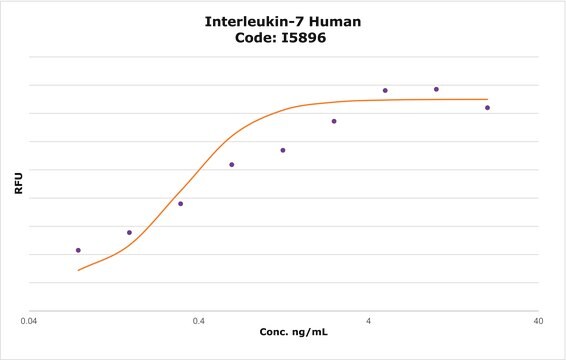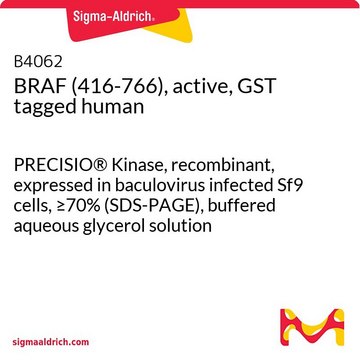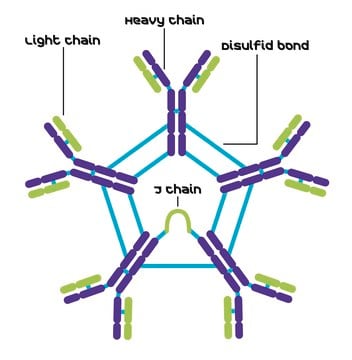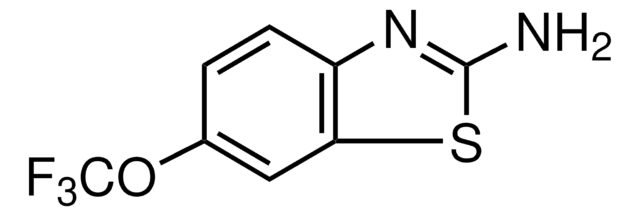I5528
Interferon-Inducible T Cell α Chemoattractant human
≥97% (SDS-PAGE), recombinant, expressed in E. coli, lyophilized powder, suitable for cell culture
Sinonimo/i:
β-R1, H174, I-TAC, SCYB9B
Autenticatiper visualizzare i prezzi riservati alla tua organizzazione & contrattuali
About This Item
Prodotti consigliati
Origine biologica
human
Livello qualitativo
Ricombinante
expressed in E. coli
Saggio
≥97% (SDS-PAGE)
Stato
lyophilized powder
Potenza
10-20 ng/mL ED50
PM
8.3 kDa
Confezionamento
pkg of 25 μg
tecniche
cell culture | mammalian: suitable
Impurezze
<0.1ng/mg
N° accesso UniProt
Temperatura di conservazione
−20°C
Informazioni sul gene
human ... CXCL11(6373)
Azioni biochim/fisiol
I-TAC (Interferon-inducible T-cell α chemoattractant) is a chemokine which participates in recruitment of inflammatory cell. It binds to receptor CXCR3 (C-X-C motif chemokine receptor 3). I-TAC is associated with the severity of dengue.
Stato fisico
Lyophilized in 30% acetonitrile and 0.1% trifluoroacetic acid containing 1.25 mg of bovine serum albumin.
Risultati analitici
The biological activity is measured by its ability to induce chemotaxis in IL-2 cultured human lymphocytes.
Codice della classe di stoccaggio
11 - Combustible Solids
Classe di pericolosità dell'acqua (WGK)
WGK 3
Punto d’infiammabilità (°F)
Not applicable
Punto d’infiammabilità (°C)
Not applicable
Scegli una delle versioni più recenti:
Possiedi già questo prodotto?
I documenti relativi ai prodotti acquistati recentemente sono disponibili nell’Archivio dei documenti.
B P Hoh et al.
Human immunology, 76(6), 421-426 (2015-04-11)
Dengue causes significantly more human disease than any other arboviruses. It causes a spectrum of illness, ranging from mild self-limited fever, to severe and fatal dengue hemorrhagic fever, as evidenced by vascular leakage and multifactorial hemostatic abnormalities. There is no
D P Widney et al.
Journal of immunology (Baltimore, Md. : 1950), 164(12), 6322-6331 (2000-06-08)
A new murine chemokine was identified in a search for glucocorticoid-attenuated response genes induced in the lung during endotoxemia. The first 73 residues of the predicted mature peptide are 71% identical and 93% similar to human CXCL11/IFN-inducible T cell alpha
M R Rani et al.
The Journal of biological chemistry, 271(37), 22878-22884 (1996-09-13)
We report preliminary characterization of a gene designated beta-R1, which is selectively expressed in response to interferon beta (IFN-beta) compared with IFN-alpha. In human astrocytoma cells, beta-R1 was induced to an equivalent extent by 10 IU/mL IFN-beta or 2500 IU/mL
Y Luo et al.
Journal of neurovirology, 4(6), 575-585 (1999-03-05)
H174 is a new member of the CXC-chemokine family. A cDNA probe containing the entire H174 coding region recognized a predominant inducible transcript of approximately 1.5 kb expressed in interferon (IFN) activated astrocytoma and monocytic cell lines. H174 message can
R Krishnan Kutty et al.
Cytokine, 74(2), 335-338 (2015-04-22)
Dysfunction of the retinal pigment epithelium (RPE) resulting from chronic inflammation is implicated in the pathogenesis of age-related macular degeneration (AMD). RPE cells adjacent to drusen deposits in the AMD eye are known to contain CXCL11, a chemokine involved in
Il team dei nostri ricercatori vanta grande esperienza in tutte le aree della ricerca quali Life Science, scienza dei materiali, sintesi chimica, cromatografia, discipline analitiche, ecc..
Contatta l'Assistenza Tecnica.








